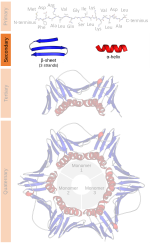 | In chemistry, a hydrogen bond (or H-bond) is primarily an electrostatic force of attraction between a hydrogen (H) atom which is covalently bonded to a... 45 KB (5,402 words) - 18:05, 27 April 2024 |
the carbon-hydrogen bond (C−H bond) is a chemical bond between carbon and hydrogen atoms that can be found in many organic compounds. This bond is a covalent... 6 KB (534 words) - 15:22, 31 January 2024 |
 | hydrogen bond is a special type of hydrogen bond in which the proton is spaced exactly halfway between two identical atoms. The strength of the bond to... 2 KB (184 words) - 23:31, 9 March 2020 |
Intermolecular force (redirect from Dipole-dipole bond) categorized into the following types: Hydrogen bonding Ion–dipole forces and ion–induced dipole force Cation–π, σ–π and π–π bonding Van der Waals forces – Keesom... 27 KB (3,384 words) - 12:46, 20 April 2024 |
 | to strong and extensive hydrogen bonding, it boils at near room temperature, much higher than other hydrogen halides. Hydrogen fluoride is an extremely... 15 KB (1,366 words) - 01:19, 9 March 2024 |
Atoms in molecules (redirect from Hydrogen hydrogen bond) two ortho hydrogen atoms again is shorter than their van der Waals radii and according to in silico experiments based on this theory, a bond path is identified... 12 KB (1,524 words) - 03:50, 9 February 2024 |
 | Hydrogen-bond catalysis is a type of organocatalysis that relies on use of hydrogen bonding interactions to accelerate and control organic reactions.... 36 KB (4,562 words) - 13:34, 1 March 2024 |
carbon–hydrogen bond activation (C−H activation) is a type of organic reaction in which a carbon–hydrogen bond is cleaved and replaced with a C−X bond (X... 32 KB (3,478 words) - 01:47, 26 March 2024 |
 | Amide (redirect from Amide bond) groups or hydrogen atoms. The amide group is called a peptide bond when it is part of the main chain of a protein, and an isopeptide bond when it occurs... 22 KB (2,121 words) - 00:25, 3 April 2024 |
molecule, the bond-dissociation energy of an oxygen–hydrogen bond varies slightly depending on whether or not there is another hydrogen atom bonded to... 9 KB (1,318 words) - 02:44, 29 April 2024 |
 | Molecular solid (section Hydrogen and halogen bonding) interactions, quadrupole interactions, π–π interactions, hydrogen bonding, halogen bonding, London dispersion forces, and in some molecular solids, coulombic... 33 KB (2,913 words) - 15:36, 1 April 2024 |
Non-covalent interaction (redirect from Non-covalent bond) (Na+). A hydrogen bond (H-bond), is a specific type of interaction that involves dipole–dipole attraction between a partially positive hydrogen atom and... 28 KB (3,363 words) - 00:54, 15 December 2023 |
Beta turn (section Hydrogen bond criterion) can be defined in two ways: By the possession of an intra-main-chain hydrogen bond between the CO of residue i and the NH of residue i+3; By having a distance... 9 KB (1,100 words) - 03:01, 2 March 2024 |
 | Beta sheet (section Hydrogen bonding patterns) proposed by William Astbury in the 1930s. He proposed the idea of hydrogen bonding between the peptide bonds of parallel or antiparallel extended β-strands... 26 KB (3,100 words) - 18:37, 22 December 2023 |
DSSP (algorithm) (redirect from DSSP (hydrogen bond estimation algorithm)) carbonyl oxygen and amide hydrogen respectively, their opposites assigned to the carbonyl carbon and amide nitrogen. A hydrogen bond is identified if E in... 5 KB (668 words) - 12:40, 30 January 2024 |
Salicylaldehyde (section Internal hydrogen bonding) internal hydrogen bond is formed between the groups. The hydroxy group serves here as the hydrogen bond donor, and the aldehyde as hydrogen bond acceptor... 9 KB (813 words) - 16:17, 6 January 2024 |
 | Properties of water (redirect from Hydrogen Hydroxide) dissociate ions in salts and bond to other polar substances such as alcohols and acids, thus dissolving them. Its hydrogen bonding causes its many unique properties... 88 KB (9,563 words) - 16:40, 31 March 2024 |
Non-canonical base pairs are planar hydrogen bonded pairs of nucleobases, having hydrogen bonding patterns which differ from the patterns observed in... 88 KB (11,728 words) - 20:32, 6 February 2024 |
formula HCl. Hydrogen chloride is a diatomic molecule, consisting of a hydrogen atom H and a chlorine atom Cl connected by a polar covalent bond. The chlorine... 27 KB (2,805 words) - 22:31, 27 April 2024 |
 | helix and π helix, are calculated to have energetically favorable hydrogen-bonding patterns but are rarely observed in natural proteins except at the... 28 KB (3,072 words) - 15:24, 4 February 2024 |
 | Chemical polarity (redirect from Polar bond) polarity if the bond dipoles cancel each other out by symmetry. Polar molecules interact through dipole-dipole intermolecular forces and hydrogen bonds. Polarity... 24 KB (2,750 words) - 01:05, 5 March 2024 |
The parent components of deep eutectic solvents engage in a complex hydrogen bonding network which results in significant freezing point depression as compared... 22 KB (2,550 words) - 15:04, 1 April 2024 |








